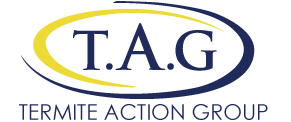Tips to help prevent termites attacking your home!
TIP 1
Termites love moisture, wetlands and wet environments. In Australia over 95% of termite attacks are by subterranean termites (Termites that burrow through soil in mud tunnels).
If you can remove the wet environments from around the home, this will assist in taking away areas which provide ready access.
Some of these examples are Leaky external hose-cocks, built up leaves in house guttering causing overflows, external hot water system overflows and watering/sprinkler systems.
These should all be fixed or removed from the immediate vicinity of the perimeter of the home.
TIP 2
Everyone knows that termites will eat timber. However, they will also eat most cellulose objects and things that produce carbon such as firewood, paper, cardboard, polystyrene, mulch, bark and some plastics.
Do not stack items up against your house as these objects may well provide shelter and cover signs of termite activity.
These items should be removed from the perimeter of the home or be placed up high on shelving with enough clearance to see under the bottom shelf (i.e. 75mm min.)
Items that emit carbon dioxide are ‘at risk’ as termites sense them as a food attractant signalling that a food source is present and they will then go foraging to find the food.
TIP 3
Gardens close to the home often provide termites with easy undetected access into the structure. Well over 95% of termite attacks come from the perimeter zone of a home and it is often the case that the termites come through garden beds.
Raised garden beds often cover weep-holes (slits between bricks to allow ventilation and moisture control) providing unrestricted access to the structural timber.
These weep-holes should always be open, clear of any obstruction, so that they can be clearly viewed and inspected for termite activity.
Gardens that are kept moist often sustain termites with food such as retaining walls, mulch, bark, stumps and fertiliser.
Termites can continue to graze in the garden for an extended period of time prior to gaining access into your home. Whilst a garden may look good aesthetically next to a home, it may present a lot of downside risks.
You are better off in having a concrete path, lawn or gravel next to the external house wall than a garden!
TIP 4
Patios, decks and verandahs should always be constructed with termites in mind!
There should always be sufficient clearance around and under the structure for inspections to take place to observe any termite activity.
This is especially the case where these structures are connected to the home as this may obstruct an inspection or cover possible entry points.
It is best to use treated timber for all adjuncts to homes and the treated timber must be maintained with suitable sealants, where required, as part of the maintenance requirements.
TIP 5
Termite Inspections are prescribed to be an annual event by the Australian Standard. However, in high termite activity areas it is best to be done every six months by a Certified Timber Pest Technician.
One inspection a year is generally not sufficient as termites can climb over and ‘bridge’ a physical termite management system within hours.
In a worse case scenario, termites can eat out the structural timber in a home in a three month period.
When a Pest Technician performs an inspection, you should be present to ask him what you can do to perform basic inspections at points where risk is present. The Pest Technician should be able to advise you of potential entry points and areas at risk.
If you have a sub-floor, you must keep it well-ventilated and check all piers and posts for mud galleries.
If you live in bushland or wetlands, you should have six monthly inspections by a Certified Timber Pest Technician and perform monthly inspections yourself based on the advice provided by the Pest Technician.
In suburban areas, an annual inspection by a Certified Timber Pest Technician should suffice and you should personally perform two-monthly inspections based on the advice provided by the Pest Technician.


